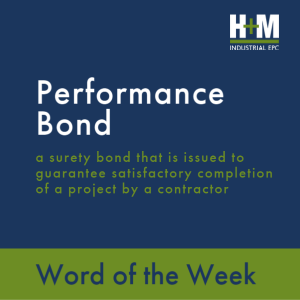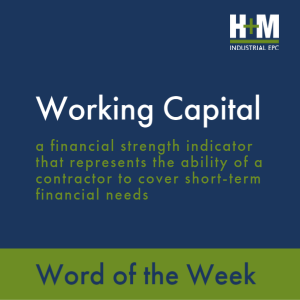Capital Project Word of the Week - Financial Operations
Thank you for visiting our Capital Project Word of the Week website feature. Our theme this month is Financial Operations. We hope this provides you with some meaningful information about our industry and the services we provide. Each week we will be adding a new Word of the Week to the page. Come back frequently to see our new additions!
Week of December 28, 2020
Percentage of Completion Revenue Recognition

[per-sen-tij ] [ uhv ] [ kuhm-plee-shuhn ] [ rev-uhn-yoo ] [ rek-uhg-nish-uhn ]
A Percentage of Completion Revenue Recognition is the most common accounting method used to recognize revenue on construction projects. This method requires the reporting of revenues and expenses on a month-by-month basis and is determined by the physical percentage of project completion in each month. Actual revenue and cost for the period are matched against the calculation of the current month percent complete multiplied by the forecasted revenue and cost for the project. The difference between these values is either an asset to the company in the form of work in progress or a liability represented as advanced billings on contracts.
Word of the Week referrals will be entered into a monthly raffle. Every referral is an entry. Good luck and share on!
Subscribe to our newsletter below to get weekly Word of the Week updates! Have a word suggestion? Send your suggestions to wow@hm-ec.com.
---
Week of December 21, 2020

Performance Bond
[per-fawr-muhns ] [ bond ]
A Performance Bond is a surety bond that is issued by a bonding company or bank to guarantee satisfactory completion of a project by a contractor. As a risk management tool, it protects the Owner/Operator in the case that a contractor fails to complete the contractual obligations. If the obligations are not met, the surety company will step in and pay the claim and seek reimbursement from the contractor. The cost for a typical Performance bond is .75% - 2% of the total bonded value.
Week of December 14, 2020
Owner Controlled Insurance Program (OCIP)

[oh-ner ] [ kuhn-trohld ] [ in-shoor-uhns ] [ proh-gram ]
An Owner Controlled Insurance Program (OCIP) is a single insurance plan designed to cover most liability arising from a construction project. OCIPs combine the coverage benefits of several key insurance policies normally used for construction projects (general liability, workers’ compensation, excess/umbrella liability, and builders’ risk) and put them into a single policy.
OCIPs are just one type of Consolidated Insurance Plans (CIP) out there. These are often referred to as “wrap-up” insurance plans because they allow coverage for multiple parties from multiple policies to be bundled into a single insurance plan. The primary benefits of these plans are cost savings for the entire insured group, consistent plan coverage across participants, and centralized management in the event of a claim.
Week of December 7, 2020

Working Capital
[ wur-king ] [ kap-i-tl ]
Working Capital is a financial strength indicator for a business and represents the ability of the contractor to cover their short-term financial needs. The formula is defined as the difference between Current Assets (cash, receivables, inventories, etc.) and Current Liabilities (accounts payable, lines of credit, etc.).
Working capital = Current Assets – Current Liabilities
Working Capital is an indicator of the amount of work a contractor can comfortably perform while remaining financially secure. Each project that is contracted consumes a portion of the contractor’s working capital while the project is underway. The amount of working capital consumed by a project is a function of the payment terms, project size, subcontractor agreements, and timing of expenditures for materials, equipment, and labor.

The H+M Industrial Team
For over three decades, we have provided best-in-class capital project management services to Energy and Chemical industries through our proven EPC approach. We are dedicated to providing trust, experience, and efficiency through all stages of engineering, procurement, and construction--on budget and on time.

Partnering with H+M Modular
H+M Modular, a division of H+M Industrial EPC, specializes in custom fabricated equipment, modules, and skids for energy and chemical industries. The approach emphasizes the potential for decreased risk through more controlled fabrication, leading to enhanced quality and safety, reduced labor costs and construction times, improved labor availability, and solutions to geographic challenges. We are dedicated to providing trust, experience, and efficiency through all stages of traditional and modular construction projects using our proven EPFC approach, If you're considering modular fabrication, we invite you to connect with us to learn about how modular solutions can improve project outcomes.





